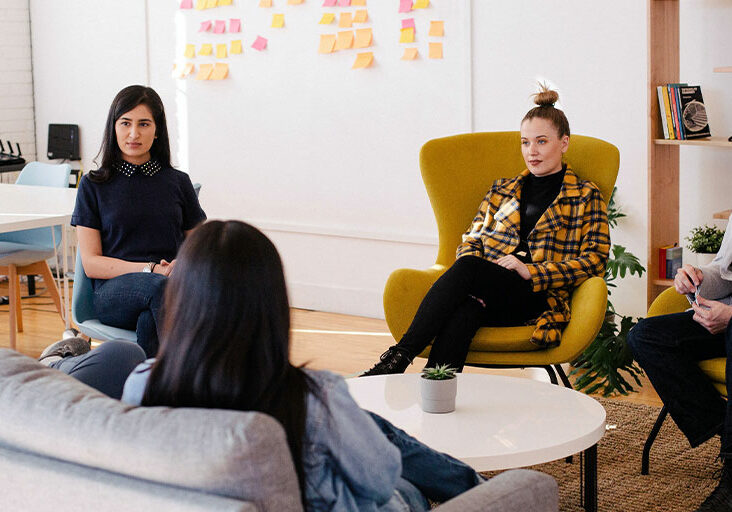Digital Transformation: The Word of an Enthusiast

Irma Barros

 Selina Thompson is the founder of Forward Transformation and a Digital Adoption & Change Consultant. For now more than 10 years, she has helped a wide range of organizations to go through all the stages of digital transformation. She made it her mission to improve the digital transformation experience for both consumers and organizations.
Selina Thompson is the founder of Forward Transformation and a Digital Adoption & Change Consultant. For now more than 10 years, she has helped a wide range of organizations to go through all the stages of digital transformation. She made it her mission to improve the digital transformation experience for both consumers and organizations.
In this interview, we asked her about her career path and the different obstacles she was confronted with along the way as well as how it impacted her perception of the IT space in this transitioning era of digital enablement.
IB – “Well, Hi, Selina. Thanks for joining me today in this interview. To start off, maybe you could tell me a bit about yourself.”
ST – “My name is Selena Thompson. I’m the founder of Forward Transformation, I run a consultancy that helps companies who are going through digital transformation and I help their people, their customers and their employees, get ready to adopt their new digital tools and services.
In addition to that, I have been consulting on digital adoption and change management for the last 13 years, started with communications, and then moved into change management, and I’m still going.”
IB – “You started with change management and due to the heavy implications of the start of the digital era you, then, chose this path?”
TS – “That’s right. For a while, I was the typical change manager on a project that’s run by IT department. They had a new system that they were rolling out and they wanted someone to help with the training and the communications.
But what I found is, I was helping the IT departments with this and actually, there’s a lot more to becoming digitally minded, having digital skills, and having a digital-first mindset. And that, people did not take into account right away. Particularly if it was an internal project, they were helping employees to master the technology, changing the way that the were working, and having new processes as a result of it, which was taking a long time.
It’s not just four weeks after you give them the new tool and you can switch the technology. It can take six months, 12 months, even longer. So that’s where I started to move more into specializing in the space of digital adoption because I believe that it’s not just about the change previous to the digital transformation. It’s also the changes that come after the adoption.”
IB – “What do you think is the first blockage that has been happening from the companies that you’ve been working with?”
ST – “I think it definitely is. It’s a challenge because decisions are made at the top level, what technology to purchase if it’s hardware equipment if it’s software and because they get the sales presentation and they get the case studies to say, well, this is what’s possible, then the senior managers are excited about this, but the person on the ground who will be receiving this new technology hasn’t had that same overview and hasn’t had that same introduction and hasn’t been a part of all these conversations for months. So by the time they get told that this is coming and you need to get on board with this, there’s just not enough time.
And so, therefore, even though we do put in good change plans, I would say that in an adoption plan, it’s still a lot of work to be able to speak to each person, understand what’s in their mind, understand their fears, and give them the chance to get on board. And that is a big challenge. I think it is a case of having everybody on the same page before you get started.”
IB – “I wanted to ask you more about that human side, if I understand correctly, you have to adapt yourself to the different stakeholders, right?”
ST – “Typically what you do is you start with what’s called your stakeholder management and mapping out who your stakeholders are, who’s got an interest in what typically is the digital transformation project. But what I’ve started doing in the last couple of years is looking more at your traditional marketing frameworks and your product management framework and looking at customer personas.
Because when you group people into personas rather than just looking at them as who has an interest in the project, you can begin to get deeper into what are the personalities that I need to work with on this change, what drives them, what motivates them, what would be the challenges for them?
And it’s a much easier way to design the change in adoption plan for them when you group it into personas. So I still have the stakeholder meetings, and I still have my stakeholder map, but I focus more on the personas.”
IB – “I understand what you mean because when you map out the persona, you kind of map their inspiration, aspirations, fears, and so on. So you go to a deeper level, but still generalizing, right?”
ST – “That’s it.”
I believe that it’s not just about the change previous to the digital transformation. It’s also the changes that come after the adoption.
IB – “Have you experienced, maybe…I’m not sure it’s okay to talk about it, but have you experienced failure, something that just didn’t work?”
ST – “It’s important to talk about it, especially in what I do. Even with all the intervention activities, you get the successes, but you are going to get some failures, and I’ve certainly had them.
I think the reasons for the failures, we’re not going to say which ones. But when I’ve had failures, it’s because I’ve not spent enough time understanding the culture of the organization and the subcultures. Because you can have what the management says is the culture, and you can talk to the leaders of each department if you like. And even when you look at external customers as well. But there are so many little subcultures when you think geographically between countries between different departments, and it’s not a one-size-fits-all.
But I think you have to tailor, tailor, and tailor again your plans.”
IB – “That makes me think about a few of my previous experiences as well. And it was not always geographically. It was also just because of the different missions of the different teams. Between engineers and product owners, and then the sales and the marketing team and the finance team, and the customer solutions team…”
ST – “The list just goes on between the different teams. And, you know, when I work on their big projects, where you’re talking to tens of thousands of people, you try and group as much as you can. But sometimes it’s just impossible, because, as you say, the cultures between the different departments are so wide.”
IB – “I assume I can’t ask you for a miracle solution here, or what would help in these situations?”
ST – “Indeed, I’m all for going out and talking to people. We’re all time-conscious now, and it’s a lot of work. The thought of having to go around different levels of the company, different departments, different personas that you’re looking for, as I was saying earlier. But unless you allocate that time to talking to people, understanding where their starting point is, and then understanding what will help them to go through the journey that you’re mapping out for them.
It makes it a lot easier later on because then you’re not having to change the plan halfway through. You’re not having to worry that you haven’t met your targets at the end because you’ve invested that time at the beginning.”
IB – “What you’re saying also is that you never had the same situation with everyone, every company that you work with.”
ST – “There are similarities, right. So I’m at a point now where I can go into a digital transformation project, and I can see the similarities from one project to another, even if it’s a different piece of technology because human behavior is similar. After all, we all think we’re very different.
There were a lot of similarities you see, with human behavior, but at the same time, I don’t walk in with the same toolkit and roll out the same activities, the same change plans that I would do for another company. I do tailor it and make it different because obviously, they are different in many ways. I don’t know if that answers your question, but, Yeah, at the same time, you do need to make sure that it is tailored to the customer that you’re working for.”
IB – “A bit on the more positive side of things in your career, what would you qualify as your best memory?”
ST – “It’s not the best one, but it’s one of my most recent ones, because, you know, it’s a lot of hours in what I do, having to strategize having to plan as having to talk to lots of people and plan the best initiative to get people with digital transformation. And I just started a new campaign to get people to stop using one tool and they’re going to be using a new tool. And I put all these communications in place. All these training sessions looked at the psyche. What’s going to make them pay attention and engage in this campaign that I put in, and I didn’t know if it had worked.
Obviously, we track things with measurements and all that, but I was reading through all the comments because it’s a social platform. So I was reading through all the comments, and I was reading what people were saying and how people were responding to the campaign. And it was really good. The comments that they had, and they were saying things like, you know, you should go and look at the training that I’ve been put on. They’re all bite-size videos, and they were copying the slogans that we had, and they were reposting the slogans.
And Yeah, I was really happy. Oh, my God, it worked. The campaign is working.”
IB – “Have you maybe seen certain differences depending on how young, or how international the company is?”
ST – “You were talking about the different mindsets before and after the adoption, so you could find some. I think you can see the difference with this. You know what? It’s not an age thing. I think people always think it’s between generations. And so well, it’s not that.
I think it’s more if you’ve had a long tenure in that company as an employee. And in that time, when you’ve been in the company, you’ve only been through change when it comes to technology. That is, every company has been through a change in terms of redundancy and organization.
But when it comes to technology, you might only have been through a technology change maybe three times in 20 years. In terms of big change, you might have had a new system or a new platform to get used to, but nothing major.
What’s happening now based in the area that we’re in, is you’re going through a digital change and all technology changes all the time, and it’s coming from you at all different angles. There are so many new tools and services to get used to. There are all these new devices to get used to, and then there’s more coming because if you take something like Microsoft, they’re just constantly releasing new things.
I think to answer your question, where do I see the differences?
It’s all to do with how technology savvy. I suppose the company is more than how long the company’s been around because you could have a company that’s been around for 100 years, but they’ve always been on top of their tech.
You can have a new company. Newish. And they don’t do a lot with the technology and that feeds into the mindset of other people.”
IB – “I was wondering also about the not how is the mindset and the culture of training and upscaling in the organizations you worked for?”
ST – “It’s a really interesting topic because I feel that the approach to training now is so different from what it was. So that when I started over a decade ago, the way that you did the training was that people had to take time off from their desk and go to a meeting room and have a trainer talk to you. And you would have your Super users or your Champions would be testing everything first, and then they share Intel.
And now I think because people don’t want to be trained, they don’t want to have training that way. It’s costly to do it. The pandemic put a stop to you doing anything face to face. But even now, even sitting in front of your laptop for an hour to two hours just isn’t going to cut it with people.
They want everything in small bite-sized chokes, and also they want the choice in the way that they access their learning.
I think probably the last four projects I’ve worked on. I’ve had to give the training in different ways, have what we call a portal where they can go and watch videos, but also give them quick reference guides like little PDF one pages also have what we call drop-in sessions and have someone give the voice over to how to learn to use the tooling.”
IB – “What are the drop-in sessions exactly?”
ST – “So drop-in sessions or ask me anything sessions. They run for an hour, typically, or half an hour. And it’s where someone can come along, and they can ask any question.
They want to get help for learning their new tool or the service that was promoted. So this is after you’ve done all the awareness campaigns. After you’ve released all the training materials that are available, you’re still giving people the opportunity to come along and ask a question and it’s a bit like a doctor’s surgery.”
IB – “If you had one favorite way of learning yourself and then of teaching, what would that be?”
ST – “You know, for me, I think we’re just missing a big trick here, because when you look at adoption platforms, like Walk me, that’s how we should be doing it. It should be where you get a chance to go into the system before it’s live. You have your little robot speaking to you and walking you through the different stages of the software that you’re using, and it’s tracking how you’re using it.
Because, it’s not until you’re in front of the technology, and you’re actually trying to do something in there that you need the help. You can go to all the surgeries. You can read all the material. You can watch all the videos, but you need hands-on help. And that’s what we just can’t do.”
IB – “Just learning by doing. And so you said that you are in the digital transformation and change management for now 10 years. What is it that motivates you? What gets you out of bed every morning?”
ST – “This is a good question. I keep coming back because I really believe in how much technology and the digital era that we’re living in can make your life easier, like I really do. And every time I see somebody, their day to day, what they’re doing is made easier because they’ve been able to master the technology that’s been asked of them. That’s what makes me happy.”
IB – “And what would you say to someone that’s starting their career just now?”
ST – “It definitely is a people job but one tip would be to develop that thick skin because, you know, it’s a challenge, right?
It’s turning more into a sales role now, a marketing role. You’ve got to be able to get people to buy into the change. And because we’re talking about digital tools and digital adoption, you’ve got to get them to want to use technology every day. So definitely be ready to to really understand people and be resistant when they say no.”
IB – “It’s a lot of persuasions. I feel like you’re a salesperson.”
ST – “It is. I honestly feel like that’s what it’s turned into.”
IB – “What do you think of the idea of mentoring in the organization as well?”
ST – “I think it’s needed. On a serious note, I feel mentoring, coaching, whichever way you want to call it. I do think that’s another reason why digital transformation isn’t quite getting to where it needs to get to because people don’t necessarily have the skills.
I suppose if you’re the receiver of the technology to be in the mindset for this constant change and the need to master the tools that you’re using and then also, I think from a leadership point of view to expand that mind and understand that you can go way further than you’ve ever gone before.
Because that’s what this is enabling you to do, right? Have all these endless possibilities. But we didn’t use to work like that. Everything was very controlled and needed a lot of consensuses before we said Yes.
To answer your question, yes, I do think mentoring is important.
I’ve had a mentor, a business mentor because I just found that in the end, you do need that support, and that helps you need to kind of be able to bounce ideas off someone who’s been there before you. It opens your mind to other things and perspectives.”
IB – “Looking back a bit. If there was something you could change in your career, what would it be?”
ST – “Good question. I probably would worry less. I think I would worry less and I would get a mentor.
No. It’s not that I would get a mentor sooner. I think I probably would be a bit bolder about having a mentoring circle because I don’t think you can get everything you need from one person. I probably would have tried to harness maybe a group of five or 10 people around me a lot earlier in my career that could guide me.”
IB – “I see, that would have given you different perspectives. And just really think about what you need from each person.”
ST – “Indeed, you might have somebody that can help you navigate politics at work, for example. But then you might have somebody who’s really good at networking that can guide you and maybe somebody who can help you how to be a woman and get to the leadership space.
Also, I think a lot of people are asking questions and they are asking themselves the same question, and they don’t realize that they could have the answer from the person just next to them as well.
I mean, I’ve worked in organizations where mentoring is this huge bureaucracy where you got to fill out all these forms and you’ve got to match yourself to people, and then it’s all got to be all part of it. And it’s all got to be all logged on with HR.
And then I understand why it is not the first thing you think of. Well, eventually, you just need a good circle of people around you.”
IB – “What you say is that it could be your colleague next to you who perhaps you look up to or inspires you?”
ST – “It could be somebody who’s the leader that you want to get to know better is saying probably worrying less and just be bolder and just walk up to them and ask.”
IB – “You mentioned there are quite some challenges and you have to have a thick skin to understand people. It’s a lot of processing and a lot of information going in your head all the time. What do you do to let go or, like you were mentioning, worrying less? How do you kind of keep sanity?”
ST – “I think you have to be kind to yourself mentally. This is something that I really tried to own more now is I think in the change space, it’s very, very intense. You can feel like you’re not doing a good job and you can feel like you’re not making strides at times, but actually, just been quite off mentally and just saying, you know, what? “You are doing a good job.” So just be kind and tell yourself nice things.
And then also, we’ve had this pandemic, but go and get, like, a massage every month and just destress, go to a spa and have dates in the diary when you’re going to just completely switch off and go and do something fun, really, self-care.”
“I hope that in the future, we don’t even call it digital transformation because actually, this is just a way of life.”
IB – “Is it something that you also advise to people are going through changes in companies that you advise?”
ST – “Yeah, it is. And it’s actually something I’m starting to think about more is how can we bring well being into the change planning and the adoption planning. Because people are going through so much change internally at work, externally in their personal lives.”
IB – “And how can we build this in?”
ST – “So it’s not all about you. But you have to get through this change. You have to get through this journey like so many changes and journey people going through. So, Yeah, I think we are factored in now.”
IB – “What do you expect to happen to the people in the digital transformation era that we’re living?”
ST – “What do I hope for? Or what do I think is going to happen?”
IB – “Actually, they’re both interesting.”
ST – “I do think we are going to get to a point where I think digital transformation leaders are going to start to question whether they need to change their methods. Because I still feel like we’re in this transition period where digital transformation leaders are not rolling out the change the way they used to because of everything that’s happened last year, you know?
And because we’re doing everything a lot faster and it can be done. But I still think that there are a lot of mindset changes, and even a lot of the ways that they run projects that need to change. We talk about agile, for example. But I don’t think people are fully there with agile principles, with being flexible. So I do think we’re going to get to a point where you’re going to have this overload of digital transformation that we’re rolling out. But actually, you’re going to take a step back and go, I don’t know if this is the right way that we’re doing, and then what do I hope for?
I hope that in the future, we don’t even call it digital transformation because actually, this is just a way of life. I hope that all the activities and changes that we’re doing are just embedded in just the way that you operate a business.”
IB – “I hope so.”
ST – “You know, for example, I hope that you have roles. You actually see digital roles coming into the play into the workplace, but I would like to see, like, a digital workplace. Whether it is with a manager role, a leading role, an analyst role, just being part of the day-to-day running.”
IB – “We’re using the term “Digital Transformation”, but it’s just that at some point, it’s just going to be what it is. “
ST – “And I honestly think after last year now we are past that stage of calling it transformation. I won’t be speaking too soon, but even some of the stuff I’m working on now for some of my clients, that’s what they’re doing. They’re just adding new technology or the next phase of the technology into what they’re doing.
There are still some industries. There are still some areas where it is a transformation, but I think we’re getting further ahead now.”
IB – “It’s very true. And thanks to you as well, actually doing your bit of help. Do you maybe have any last thoughts to share with me today?”
ST – “I would like, actually in the digital transformation space, more emphasis on digital adoption and change. I still feel like it doesn’t get enough attention. It’s still very much around technology and what people did. But the actual effort it takes to do the change. I would like to see that part more.”
IB – “I feel that at the moment, it’s very focused on businesses that are already enabled by technology at several levels but in different industries not so exposed, it is not really the case.”
ST – “No industry is going through the same thing. There just isn’t. And for some reason, it’s still very much talking about digital transformation in the corporate base. And maybe the education space people are always interested in, you know, Ed-tech, but it’s so much broader, and that actually focuses the conversation on people. It doesn’t matter about the industry.”
IB – “Exactly. Thank you so much for taking the time to answer my questions today Selina. We’ve come to the end of the interview. I would like to thank you for taking the time to answer my question and give us your insights so that we can understand digital transformation at a deeper level.”
ST – “Thanks for inviting me, Irma. It was great. Thank you so much.”
Never miss an interesting article
Get our latest news, tutorials, guides, tips & deals delivered to your inbox.
Keep learning

CCC Digital Hub Learnings
- « Previous
- 1
- 2
- 3
- 4
- Next »


